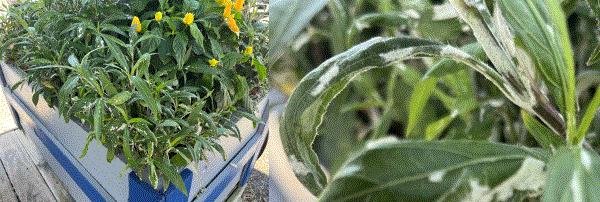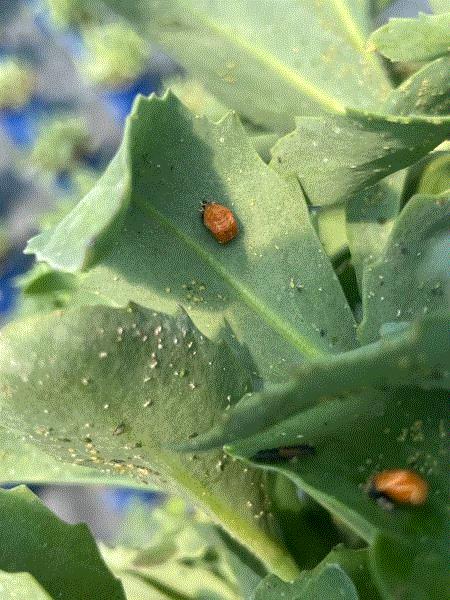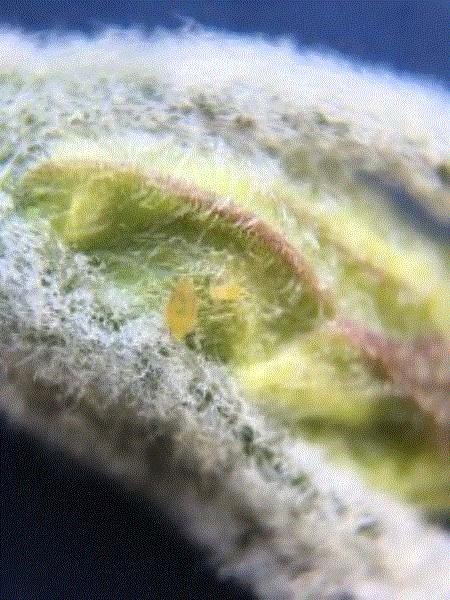What the ... ?
Marion Whaley of Edisto Beach sent me a couple of pictures a couple of weeks ago. Although Marion doesn’t manage my landscape anymore (because I now have a stamp-size mixed-species lawn that I can clean up with a push mower), he still thinks enough of me to chat when we catch each other on narrow island roads and sends me questions.

What is this white fuzz on these Mexican petunias? (Photo credit: Marion Whaley, Whaley's Landscaping and Irrigation, Inc.)
Marion found quite a bit of white fuzz on the leaves of Mexican petunias. In fact, it’s probably best described as white fur on the leaves. He said he couldn’t wipe them off easily at all. I've seen the same phenomenon frequently on my travels up and down Florida, most recently on a Mexican petunia at a rest stop near Fort Pierce.
What is this white fuzz?
Managing Aphids on Mums
Folks are finding aphids on mums in the field—so what can you do about it?
Occasionally, these aphid infestations are accompanied by lots of mummies and ladybeetles. That’s actually a good sign, at least from my perspective as an insect ecologist. It means to me that you either haven’t had an aphid infestation until now or you haven’t been using broad-spectrum insecticides.
But an infestation is an infestation, so it still needs to be taken care of. Nobody wants cast skins, honeydew and sooty mold on the mums. Even ladybeetle pupae freak people out.

It's normal to find ladybeetle larvae and pupae with aphid infestations. These ladybeetles are like aphid-seeking missiles. (Photo source: Jeff Hermes, Heritage Professional Products Group.)
More biological control? Perhaps. The only predator I think may be suitable in this case are the green lacewing larvae, which will likely stay put and feed on the aphids. Entomopathogenic fungi are also options, which can be sprayed just like conventional insecticides. Several products containing the fungi Beauveria bassiana and Isaria fumosorosea, the bacterium Chromabacterium subtsugae, and the bacterial fermentation product from Burkholderia species are available for this purpose.
Aphids aren't difficult to control with conventional insecticides and there are lots of options available. The key to successful management is to find the infestation early and deal with them as soon as possible. Aphid populations grow very fast, so a few days’ delay may set your management program back quite a bit.
I would start the management program with a preventive treatment with a drench of systemic insecticides. My preference is to start with neonicotinoids, but if you can’t or won’t use neonicotinoids, then there are other systemic insecticides, such as flupyradifurone (Aria) and spirotetramat (Kontos). I’m usually not a fan of preventive treatments for the sake of just preventing pests in general. However, I think a preventive drench is highly suitable for field mum production because you’ll eventually get aphid infestations, so might as well make a preventive drench and reduce the risk of severe infestation in the next few weeks.
Preventive drenches don’t last forever, so an infestation will appear at some time later. There are many effective options for aphid management. Again, most insecticides are quite effective against aphids. The keys to success are to spray when the aphid population is small (so find them early) and achieve thorough spray coverage (particularly the underside of leaves).
Go HERE to download an insecticide poster where I listed all the insecticide active ingredients registered for aphid management (and other pests, too). Rotation programs for some major pests are on the back side of the poster.
One insecticide group that I recommend highly are the chordotonal organ modulators, including afidopyropen (Ventigra), pymetrozine (Endeavor), pyrifluquinazon (Rycar, greenhouse only) and flonicamid (Aria). Go HERE for an article discussing the efficacy of chordotonal organ modulator insecticides for aphid management.
Aphids aren't the only pests you’ll ever encounter on field mums. Go HERE for an earlier issue of this newsletter on pest and disease management in mums.

Answer to “What the … ?”
Did Marion find powdery mildew, mealybugs, planthoppers or some extra-terrestrial mold-like invaders on the Mexican petunias? Neither of those.
The white fur on the Mexican petunias are in fact excessive growth of leaf trichomes, AKA erinea (or erineums) by fancy scientific folks. This type of excessive trichome growth is caused by feeding of eriophyid mites or gall mites.
I assume most of you know what an eriophyid mite is. Eriophyid mites constitute a large group of tiny, four-legged, banana-shaped mites that cause all kinds of damage to plants, ranging from galls to rust. Some notable members are the species that vectors rose rosette diseases throughout the country and the aloe mite I’ve been hearing about in California.

Eriophyid mites in erinea. (Photo credit: Michelle Leonard-Mularz, University of Florida IFAS Extension.)
It’s not entirely clear how eriophyid mites cause galls or distorted growth on plant tissues; it could be a toxin or growth regulator in their saliva or simply by the action of feeding. What’s clear is that erinea provide perfect shelter for the tiny eriophyid mites to continue growing a population on the affected plants.
Go HERE for a blog post on this interesting white fur on Mexican petunias.

Managing Eriophyid Mites
It’s interesting to me that the blog post on erinea on Mexican petunias by Michelle Leonard-Mularz of the University of Florida IFAS Extension (and another by Sheila Dunning, also of University of Florida IFAS Extension) recommend removal of purple Mexican petunia as a management approach. This remove-and-replace approach is obviously quite suitable for an invasive species like the Mexican petunia. I think this approach is also suitable for rose rosette diseases, which doesn’t have a cure. (If only rose lovers will ever listen to me.)
Some species may be pruned back and allowed to reflush, but additional management will be needed to prevent reinfestation. It’s critical that the pruned materials are removed from the site immediately to avoid the mites from leaving the desiccating plant tissue and going back to the surviving tissue. This isn't going to work for plants that are infected with systemic diseases carried by the eriophyid mites. For example, roses infected with rose rosette virus will forever grow weird even if they’re pruned.

Sometimes, there are very few options for managing eriophyid mites and the diseases they vectored, such as rose rosette disease. (Photo credit: JC Chong.)
This approach also may not be suitable for other more desirable species, such as citrus affected by citrus rust mite, aloes affected by aloe mite, or hemp or cannabis affected by hemp russet mite. For these pests, chemical control is often needed to reduce the population and damage.
Unlike spider mites, there are unfortunately few miticide options against eriophyid mites. Some of the most effective miticides I’d tried are abamectin (Avid, Sirocco, etc.; IRAC 6), chlorfenapyr (Pylon; 13), fenpyroximate (Akari; 21A), spiromesifen (Savate or Forbid; 23), spirotetramat (Kontos; 23), and horticultural oil. Many folks also used carbaryl for managing eriophyid mites; I don’t have a whole lot of experience in this use. The efficacy of pyrethroids was rather inconsistent in my trials. Adding a surfactant to the spray solution will improve spreading, coating and penetration of tight places on plants and improve efficacy of the miticide sprays.
Biological control is certainly an option. The predatory mites Amblyseius andersoni and Neoseiulus californiacus have been used for managing eriophyid mites in some operations. It’s best to use biological control from the beginning of the crop to prevent damage since damage by eriophyid mites are often permanent. The efficacy of entomopathogens was inconsistent in my experience.
Go HERE for one of my articles from the academia days and HERE for a GrowerTalks article on managing mites.





See y'all later!

JC Chong
Technical Development Manager at SePRO
Adjunct Professor at Clemson University
This e-mail received by 27,847 subscribers like you!
If you're interested in advertising on PestTalks contact Kim Brown ASAP!